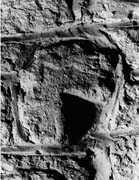Select a site alphabetically from the choices shown in the box below. Alternatively, browse sculptural examples using the Forward/Back buttons.
Chapters for this volume, along with copies of original in-text images, are available here.
Object type: Part of cross-head [1]
Measurements: H. 25 cm (9.8 in); W. 21 cm (8.25 in)
Stone type: Coarse, shelly, yellow (10YR 7/6) limestone; Coral Rag, Coralline Oolite Formation, Middle Oxfordian, Upper Jurassic; nearest source is North Grimston (see Fig. 5)
Plate numbers in printed volume: 503
Corpus volume reference: Vol 3 p. 151
(There may be more views or larger images available for this item. Click on the thumbnail image to view.)
Only one face is visible.
A (broad): The fragment consists of the lower and one lateral arm of a cross-head of type 6, with broad arms and a recessed, plain ring of type 1(a). A continuous plain edge moulding runs round its perimeter. Within the moulding is a crudely carved Crucifixion: the figure is set rather high in the cross-head, with one pointed foot occupying only the upper part of the lower arm. Christ wears a short kirtle and His arm is dipped at the elbow. The hand is splayed. The head and other limbs are now lost.
B–D: Built in.
Such ring-headed crosses are likely to have appeared in Yorkshire only after c. 920 when they were introduced by Norse-Irish colonists (Bailey 1978, 177–9), though this does not imply an ethnic character for this particular fragment. With this type of cross came a fashion for setting the Crucifixion on the face of the cross-head in the Irish manner. The dipped elbow is found on a fine tenth-century head from St Mary Castlegate, York (no. 2; Ill. 297), as well as in a more comparable crude form, with large splayed hand, in a group at the eastern end of Wensleydale, West Riding: for example, Thornton Watlass, and Finghall, where similar ring-heads are to be found.
The cutting is crude and in very low relief, though not incised. It is in marked contrast to the cutting styles of nos. 1–3, and is altogether less ambitious. The nearest ring-head is at North Frodingham (Ills. 695–8), a superior monument which may have inspired copies in the locality.



